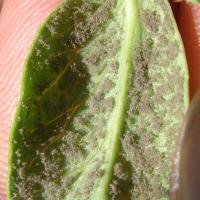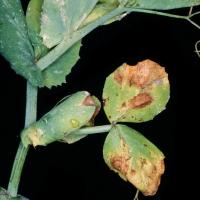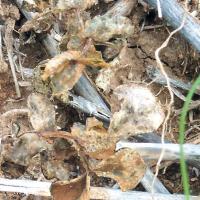Diagnosing downy mildew in field peas
Low levels of downy mildew Perenospora viciae are sometimes noticed in field pea crops late in winter, but crops usually grow away from it during the longer warmer spring days.
What to look for
- Pale yellowish-green plants with fluffy grey spores on the leaf underside. symptoms are worse in cold wet weather and in wetter parts of the paddock.
Paddock
- Pale yellow-green blotches on the upper surface of leaves with fluffy mouse-grey spore masses in equivalent positions on the leaf underside.
- The blotches turn greenish-brown and shrivel and the leaf dies.
- The fungus usually affects the lowest leaves and then progresses up the plant, if conditions permit, infecting flowers and pods. Infected pods are deformed and covered with yellow to brownish areas and superficial blistering.
- Seedlings that are systemically infected are pale yellowish-green, stunted and distorted.
- Downy mildew makes plants more vulnerable to herbicide damage by affecting the protective wax coating on leaves.
Plant
What else could it be
| Condition | Similarities | Differences |
|---|---|---|
| Diagnosing powdery mildew in field peas | Pale fluffy spore masses on leaves | Spores are on the upper rather than underside of leaves, and the disease occurs in spring rather than winter |
Where did it come from?

Contaminated soil
- The downy mildew fungus survives in the soil for 10 to 15 years, and also on plant residues. Infection from these souces can lead to systemic and leaf infections in volunteer pea seedlings. These seedlings act as a source of infection from which the disease spreads by wind to adjacent plants and crops.
Management strategies
- Downy mildew is a minor disease in Western Australia. Control is rarely required as the plant usually recovers in spring.
- Variety Kaspa is resistant to the common Parafield strain of the fungus, but susceptible to the new Kaspa strain.
See also
Further information
Where to go for expert help
Page last updated: Wednesday, 13 May 2015 - 1:45pm





